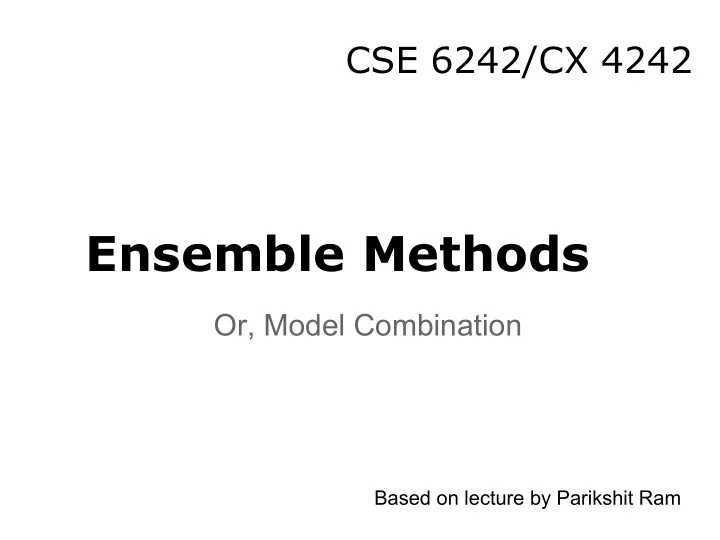

CSE 6242/CX 4242 Ensemble Methods Or, Model Combination Based on lecture by Parikshit Ram
Numerous Possible Classifiers! Classifier Training Cross Testing Accuracy time validation time kNN None Can be slow Slow ?? classifier Decision Slow Very slow Very fast ?? trees Naive Fast None Fast ?? Bayes classifier … … … … …
Which Classifier/Model to Choose? Possible strategies: • Go from simplest model to more complex model until you obtain desired accuracy • Discover a new model if the existing ones do not work for you • Combine all (simple) models
Common Strategy: Bagging (Bootstrap Aggregating) Consider the data set S = {(x i , y i )} i=1,..,n • Pick a sample S * with replacement of size n from S • Train on this set S * to get a classifier f * • Repeat above steps B times to get f 1 , f 2 ,...,f B • Final classifier f(x) = majority {f b (x)} j=1,...,B
Common Strategy: Bagging Why would bagging work? • Combining multiple classifiers reduces the variance of the final classifier When would this be useful? • We have a classifier with high variance (any examples?)
Bagging decision trees Consider the data set S • Pick a sample S * with replacement of size n from S • Grow a decision tree T b greedily • Repeat B times to get T 1 ,...,T B • The final classifier will be
Random Forests Almost identical to bagging decision trees, except we introduce some randomness: • Randomly pick any m of the d attributes available • Grow the tree only using those m attributes That is, Bagged random decision trees = Random forests
Points about random forests Algorithm parameters • Usual values for m: • Usual value for B : keep increasing B until the training error stabilizes
Bagging/Random forests Consider the data set S = {(x i , y i )} i=1,..,n • Pick a sample S * with replacement of size n from S • Do the training on this set S * to get a classifier (e.g. random decision tree) f * • Repeat the above step B times to get f 1 , f 2 ,...,f B • Final classifier f(x) = majority {f b (x)} j=1,...,B
Final words Advantages • Efficient and simple training • Allows you to work with simple classifiers • Random-forests generally useful and accurate in practice (one of the best classifiers) • Embarrassingly parallelizable Caveats: • Needs low-bias classifiers • Can make a not-good-enough classifier worse
Final words Reading material • Bagging: ESL Chapter 8.7 • Random forests: ESL Chapter 15 http://www-stat.stanford.edu/~tibs/ElemStatLearn/printings/ESLII_print10.pdf
Strategy 2: Boosting Consider the data set S = {(x i , y i )} i=1,..,n • Assign a weight w (i,0) = (1/n) to each i • Repeat for t = 1,...,T : o Train a classifier f t on S that minimizes the weighted loss: o Obtain a weight a t for the classifier f t o Update the weight for every point i to w (i, t+1) as following: � Increase the weights for i: � Decrease the weights for i: • Final:
Final words on boosting Advantages • Extremely useful in practice and has great theory as well • Can work with very simple classifiers Caveats: • Training is inherently sequential o Hard to parallelize Reading material: • ESL book, Chapter 10 • Le Song's slides: http://www.cc.gatech.edu/~lsong/teaching/CSE6704/lecture9.pdf
Visualizing Classification Usual tools • ROC curve / cost curves o True-positive rate vs. false-positive rate • Confusion matrix
Visualizing Classification Newer tool • Visualize the data and class boundary with 2D projection (dimensionality reduction)
Weights in combined models Bagging / Random forests • Majority voting Let people play with the weights?
EnsembleMatrix http://research.microsoft.com/en-us/um/redmond/groups/cue/publications/CHI2009-EnsembleMatrix.pdf
Understanding performance • • http://research.microsoft.com/en-us/um/redmond/groups/cue/publications/CHI2009-EnsembleMatrix.pdf
Improving performance http://research.microsoft.com/en-us/um/redmond/groups/cue/publications/CHI2009- EnsembleMatrix.pdf
Improving performance • Adjust the weights of the individual classifiers • Data partition to separate problem areas o Adjust weights just for these individual parts • State-of-the-art performance, on one dataset http://research.microsoft.com/en-us/um/redmond/groups/cue/publications/CHI2009-EnsembleMatrix.pdf
ReGroup - Naive Bayes at work http://www.cs.washington.edu/ai/pubs/amershiCHI2012_ReGroup.pdf
ReGroup Gender, Age group Y - In group? Family X - Features of a friend Home city/state/country P(Y = true|X) = ? Current city/state/country High school/college/grad school Compute P(X d |Y = true) for Workplace each feature d using the Amount of correspondence current group members Recency of correspondence (how?) Friendship duration # of mutual friends Amount seen together Features to represent each friend http://www.cs.washington.edu/ai/pubs/amershiCHI2012_ReGroup.pdf
ReGroup Not exactly Y - In group? X - Features of a friend classification! P(Y|X) = P(X|Y)P(Y)/P(X) P(X|Y) • Reorder remaining = P(X 1 |Y)*...*P(X d | friends with respect Y) to P(X|Y=true) • "Train" every time a Compute P(X i |Y = true) new member is for every feature d added to the group using the current group members • Use simple counting http://www.cs.washington.edu/ai/pubs/amershiCHI2012_ReGroup.pdf
Some additional reading • Interactive machine learning o http://research.microsoft.com/en-us/um/redmond/groups/cue/iml/ o http://research.microsoft.com/en-us/um/people/samershi/pubs.html o http://research.microsoft.com/en-us/um/redmond/groups/cue/publications/ CHI2009-EnsembleMatrix.pdf o http://research.microsoft.com/en-us/um/redmond/groups/cue/publications/ AAAI2012-PnP.pdf o http://research.microsoft.com/en-us/um/redmond/groups/cue/publications/ AAAI2012-L2L.pdf
Recommend
More recommend